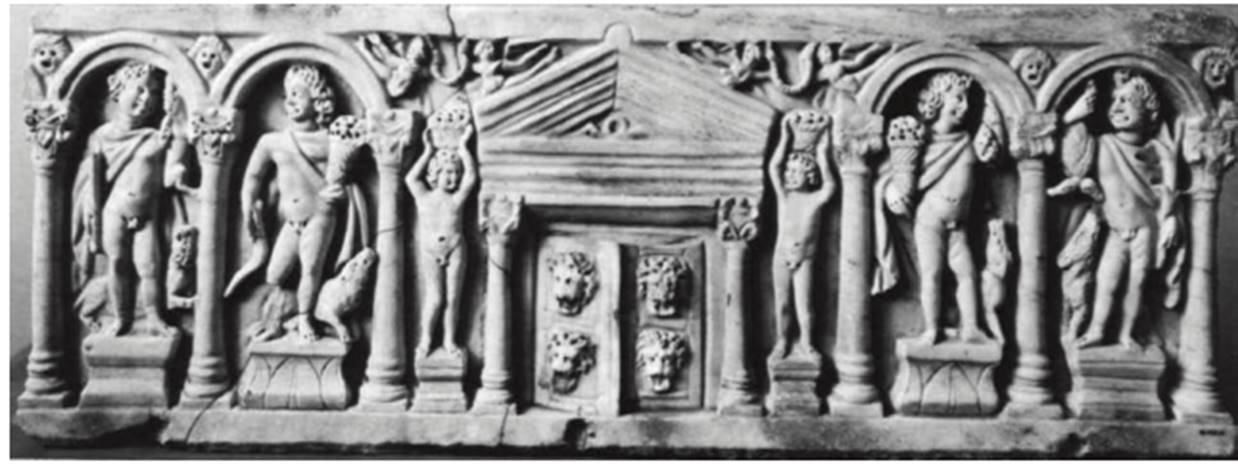Child's sarcophagus with seasons. Rome (?), early 4th century. Proconnesian marble
Cut from a child's sarcophagus, this slab is in two large pieces, with a roughly triangular restoration to the left of the aedicula. The animal in the restoration is worked separately and may be a reused piece of the cutaway casket. The upper edge is chipped above the third column from the left; the lower edge has modern cuttings for brackets or clamps to hold the slab upright for display.
The front is divided into five sections: a central gabled doorway and four narrow spaces defined by columns supporting arches, in which stand personifications of seasons. Imitating statues on pedestals, they face each other in pairs. The seasons, identifiable by their attributes, are, from left to right: Spring holding up a rabbit; Summer carrying a sickle and basket; Autumn with a bunch of grapes and basket; and Winter with ducks and a reed. Each is accompanied by an animal, also used as seasonal reference—a boar with Winter, a goat (?) with Autumn, a hunting dog with Spring.

The wide central section is filled by a tomb facade with apotropaic lion masks on the door valves, both slightly ajar. The facade is flanked by basket-carrying Erotes on pedestals with pairs of winged genii carrying garlands above. The spandrels between arches are filled by theater masks.
The large corpus of season sarcophagi in the West ranges from around a.d. 200 to approximately the mid-fourth century; by mid-third century, a distinctly Italian variant had evolved, which combined the basic elements of architectural decor, originally of east Mediterranean origin, with the seasons; and, as on this slab, the tomb facade appeared on the front, rather than the right end, the rule with Eastern examples.
The symbolism of the seasons is multivalent; among many concepts, it may connote the perpetual cycle of time and change, a tendentious metamorphosis from spring (birth) to winter (death), ideas of fertility and renewal, as well as the gifts brought to the tomb throughout the year as memorial offerings. The full range of monuments and ideas has been treated by Hanfmann (1951, I) and Lawrence (1958) has discussed the formally related group of seasons represented in an architectural context.
The large scale of the figures, the reduction of space to one plane, and adherence to a symmetrical design emphasize the linear and coloristic effects of the carving. The jowly and summarily modeled flesh of these youths, the placement of drill holes, and the weak anatomical execution indicate a date in the late third or early fourth century. These procedures may be compared to other sarcophagi that are close in date (e.g., Bovini and Brandenburg, 1967, I, nos. 5, 12, 67, 794b); an early fourth-century date is preferred because of the incised eyebrows (cf. Hanfmann, 1951, I, nos. 500, 515). Greater precision in dating is precluded by the sculptors' tendency to execute children's sarcophagi with less care than large ones, evident here in the misshapen columns and uneven surface of the background.
Purchased in Rome. Bibliography: Hanfmann, 1951,1, no. 490, fig. 56; Lawrence, 1958, pp. 275-276, pi. 73, fig. 6.
Date added: 2025-08-31; views: 86;
